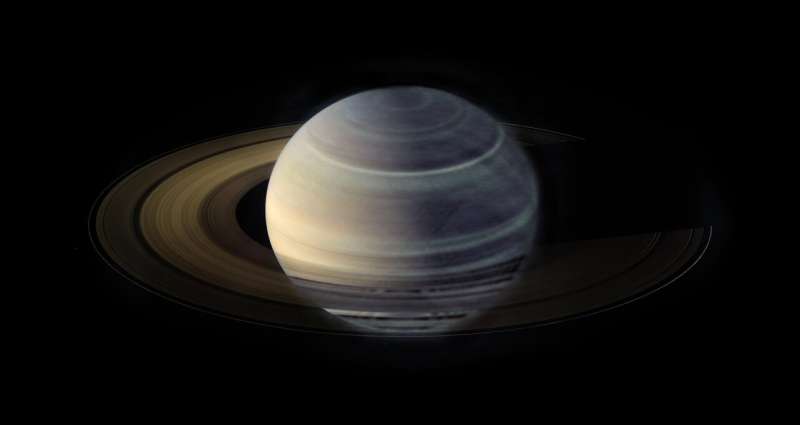
In the optical, Saturn’s banded atmosphere appears to smoothly shift from color to color. But seen here in radio light — VLA data overlays a Cassini image of Saturn — the distinct nature of the bands is apparent. Scientists used VLA data to better understand ammonia in the gas giant’s atmosphere and learned that megastorms transport the ammonia from the upper to the lower atmosphere. Credit: S. Dagnello (NRAO/AUI/NSF), I. de Pater et al (UC Berkeley)
The largest storm in the solar system, a 10,000-mile-wide anticyclone called the Great Red Spot, has decorated Jupiter’s surface for hundreds of years.
A new study now shows that Saturn—though much blander and less colorful than Jupiter—also has long-lasting megastorms with impacts deep in the atmosphere that persist for centuries.
The study was conducted by astronomers from the University of California, Berkeley, and the University of Michigan, Ann Arbor, who looked at radio emissions from the planet, which come from below the surface, and found long-term disruptions in the distribution of ammonia gas.
The study was published today in the journal Science Advances.
Megastorms occur approximately every 20 to 30 years on Saturn and are similar to hurricanes on Earth, although significantly larger. But unlike Earth’s hurricanes, no one knows what causes megastorms in Saturn’s atmosphere, which is composed mainly of hydrogen and helium with traces of methane, water and ammonia.
“Understanding the mechanisms of the largest storms in the solar system puts the theory of hurricanes into a broader cosmic context, challenging our current knowledge and pushing the boundaries of terrestrial meteorology,” said lead author Cheng Li, a former 51 Peg b Fellow at UC Berkeley who is now an assistant professor at the University of Michigan.
Radio image of Saturn taken with the VLA in May 2015, with the brighter radio emissions from Saturn and its rings subtracted to enhance the contrast in the fainter radio emissions between the various latitudinal bands in the atmosphere. Since ammonia blocks radio waves, the bright features indicate areas where ammonia is depleted and the VLA could see deeper in the atmosphere. The broad bright band at northern latitudes is the aftermath of the 2010 storm on Saturn, which apparently depleted ammonia gas just below the ammonia-ice cloud, which is what we see with the naked eye. Credit: R. J. Sault and I. de Pater
Imke de Pater, a UC Berkeley professor emerita of astronomy and of earth and planetary sciences, has been studying gas giants for over four decades to better understand their composition and what makes them unique, employing the Karl G. Jansky Very Large Array in New Mexico to probe the radio emissions from deep inside the planet.
“At radio wavelengths, we probe below the visible cloud layers on giant planets. Since chemical reactions and dynamics will alter the composition of a planet’s atmosphere, observations below these cloud layers are required to constrain the planet’s true atmospheric composition, a key parameter for planet formation models,” she said. “Radio observations help characterize dynamical, physical and chemical processes including heat transport, cloud formation and convection in the atmospheres of giant planets on both global and local scales.”
As reported in the new study, de Pater, Li and UC Berkeley graduate student Chris Moeckel found something surprising in the radio emissions from the planet: anomalies in the concentration of ammonia gas in the atmosphere, which they connected to the past occurrences of megastorms in the planet’s northern hemisphere.
A huge storm dominates the rather featureless surface of Saturn in an image taken by the Cassini spacecraft on Feb. 25, 2011, about 12 weeks after the powerful storm was first detected in the planet’s northern hemisphere. The megastorm is seen overtaking itself as it encircles the entire planet. Astronomers have found deep in the atmosphere the aftereffects of megastorms that occurred hundreds of years ago. The dark stripes are the shadows of Saturn’s rings. Credit: NASA/JPL/Space Science Institute
According to the team, the concentration of ammonia is lower at midaltitudes, just below the uppermost ammonia-ice cloud layer, but has become enriched at lower altitudes, 100 to 200 kilometers deeper in the atmosphere. They believe that the ammonia is being transported from the upper to the lower atmosphere via the processes of precipitation and reevaporation. What’s more, that effect can last for hundreds of years.
The study further revealed that although both Saturn and Jupiter are made of hydrogen gas, the two gas giants are remarkably dissimilar. While Jupiter does have tropospheric anomalies, they have been tied to its zones (whitish bands) and belts (darkish bands) and are not caused by storms like they are on Saturn. The considerable difference between these neighboring gas giants is challenging what scientists know about the formation of megastorms on gas giants and other planets and may inform how they’re found and studied on exoplanets in the future.
More information:
Cheng Li, Long-lasting, deep effect of Saturn’s Giant Storms, Science Advances (2023). DOI: 10.1126/sciadv.adg9419. www.science.org/doi/10.1126/sciadv.adg9419
Citation:
Hundred-year storms? That’s how long they last on Saturn (2023, August 11)
retrieved 11 August 2023
from https://phys.org/news/2023-08-hundred-year-storms-saturn.html
This document is subject to copyright. Apart from any fair dealing for the purpose of private study or research, no
part may be reproduced without the written permission. The content is provided for information purposes only.
>>> Read full article>>>
Copyright for syndicated content belongs to the linked Source : Phys.org – https://phys.org/news/2023-08-hundred-year-storms-saturn.html
